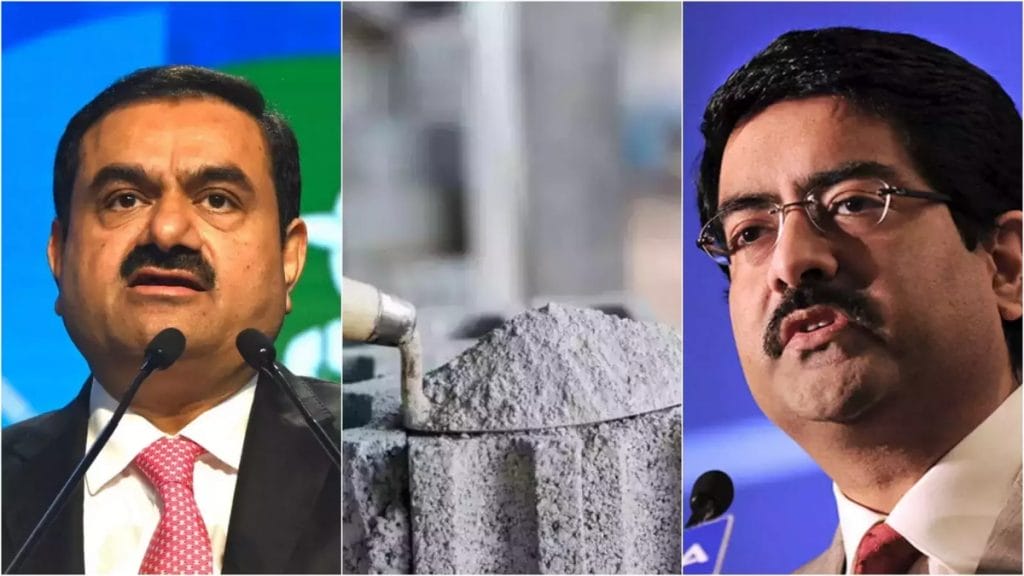New Delhi: In India’s cement sector, major competition has grown between Kumar Mangalam Birla’s UltraTech Cement Ltd. and Gautam Adani’s quick growth. Both billionaires are putting a lot of effort into expanding their capabilities and acquiring new assets in order to control the supply of this essential building material, which is necessary for the development of India’s infrastructure.
Adani and UltraTech have already made six deals in less than two years. Birla’s cement company recently announced its seventh deal, buying a key regional player. With several smaller competitors still available, the competition is set to grow. Aditya Kondawar, a partner at Complete Circle Capital Pvt., said that Adani’s entry has brought new energy into the sector, pushing UltraTech to expand more. He explained, “Adani’s strategy is to dominate and aggressively compete whenever they enter a sector.”
Adani Group’s dramatic entry in 2022, through the acquisition of Ambuja Cements Ltd. and ACC Ltd., made it the second-largest cement producer in India. However, the company spent much of 2023 dealing with the fallout from a critical report by Hindenburg Research. It has resumed its expansion in 2024, sparking a turf war with UltraTech, which is defending its market position.
Leadership Moat:
UltraTech has been strengthening its position by acquiring smaller rivals. In June, it increased its stake in a Chennai-based cement company to a majority, signaling its intent to fend off Adani. UltraTech aims to reach an annual capacity of 200 million tonnes by 2027. Representatives from Adani Group and UltraTech did not comment on these developments.
M&A War Chest:
Adani Group aims to double its annual production capacity to 140 million tonnes by 2028 and is actively seeking more acquisitions. The group reportedly has a $4.5 billion fund for acquisitions over the next two years. Adani plans to use its extensive port network to reduce transportation costs and its green energy projects to lower fuel expenses.
Hunting Ground:
Southern India has become a key target for both Adani and Birla. Adani’s purchase of Penna Cement in June aimed to strengthen its presence in the south, while UltraTech quickly responded by acquiring a significant stake in India Cements Ltd., a move to preempt Adani. UltraTech recently increased its stake in India Cements to over 55 percent, enhancing its ability to serve southern markets and moving closer to its 200 million tonnes target.
Aveek Mitra, founder of Aveksat Investment Advisory, emphasized the inevitability of acquisitions in the cement industry due to government infrastructure spending. Anupama Reddy from ICRA Ltd. indicated that ongoing M&A activity is driven by large players’ desire to maintain market share.
Mission to Build:
Prime Minister Narendra Modi’s infrastructure projects, expected to drive investment to Rs 15 trillion ($179.2 billion) by March 2026, are likely to significantly boost cement demand. This surge in demand presents expansion opportunities that both Adani and Birla find irresistible. Adani’s recent acquisition of Penna Cement Industries Ltd. and interest in other companies like Jaypee Group and Orient Cement Ltd. highlight the intensifying competition. Orient Cement has also attracted interest from UltraTech.
Analysts Sanjeev Kumar Singh and Mudit Agarwal from Motilal Oswal Financial Services Ltd. noted that southern India is the most fragmented market, with many firms not expanding their capacities over the years. They suggest that some companies might exit the industry if offered good prices.
Given the massive capacity inequality, Adani might still have difficulty overtaking UltraTech even with its aggressive growth. Both businesses will have to remain clear of acquisitions in areas where they already hold a substantial market share and deal with antitrust scrutiny. Although the demand for cement is high right now, Jyoti Gupta, a research analyst at Nirmal Bang Institutional Equities, warned that it may fall in the coming years, raising questions regarding the financial viability of the increased capacity.





